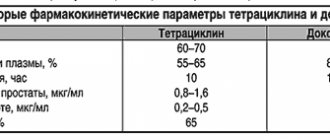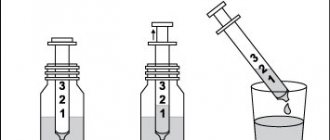Sumatrolid Solution Tablets
Antacids
do not affect the bioavailability of azithromycin, but reduce the maximum concentration of azithromycin by 30%, so azithromycin should be taken 1 hour before or 2 hours after taking antacids.
Cetirizine:
simultaneous use of azithromycin with cetirizine (20 mg) for 5 days in healthy volunteers did not lead to pharmacokinetic interaction and a significant change in the QT interval.
Didanosine:
simultaneous use of azithromycin (1200 mg/day) and didanosine (400 mg/day) in 6 HIV-infected patients did not reveal changes in the pharmacokinetic parameters of didanosine compared to the placebo group.
Digoxin
: Concomitant use of macrolide antibacterial drugs, including azithromycin, with
P-glycoprotein substrates,
such as digoxin, leads to increased plasma concentrations of P-glycoprotein substrate. Thus, with the simultaneous use of digoxin and azithromycin, it is necessary to take into account the possibility of increasing the concentration of digoxin in the blood plasma.
Zidovudine:
simultaneous use of azithromycin (single dose of 1000 mg and multiple doses of 1200 mg or 600 mg) has a minor effect on the pharmacokinetics, including renal excretion, of zidovudine or its glucuronide metabolite. However, the concentration of the active metabolite, phosphorylated zidovudine, in peripheral blood mononuclear cells increases. The clinical significance of this fact is unclear.
Azithromycin interacts weakly with isoenzymes of the cytochrome P450 system. Azithromycin has not been shown to participate in pharmacokinetic interactions similar to erythromycin and other macrolides. Azithromycin is not an inhibitor or inducer of cytochrome P450 isoenzymes.
Ergot alkaloids:
taking into account the theoretical possibility of the development of ergotism. simultaneous use of azithromycin with ergot alkaloid derivatives (ergotamine, dihydroergotamine) is not recommended.
Pharmacokinetic studies were conducted on the simultaneous use of azithromycin and drugs whose metabolism occurs with the participation of isoenzymes of the cytochrome P450 system.
Atorvastatin
: Concomitant use of atorvastatin (10 mg daily) and azithromycin (500 mg daily) did not cause changes in plasma concentrations of atorvastatin (based on an HMC-CoA reductase inhibition assay). However, cases of rhabdomyolysis have been reported in patients receiving concomitant azithromycin and statins.
Carbamazepine
: in pharmacokinetic studies involving healthy volunteers, there was no significant effect on the concentration of carbamazepine and its active metabolite in the blood plasma when used simultaneously with azithromycin.
Cimetidine:
In pharmacokinetic studies of the effect of a single dose of cimetidine on the pharmacokinetics of azithromycin, no changes in the pharmacokinetics of azithromycin were detected, provided that cimetidine was used 2 hours before azithromycin.
Indirect anticoagulants (coumarin derivatives):
In pharmacokinetic studies, azithromycin did not affect the anticoagulant effect of warfarin in a single dose of 15 mg taken by healthy volunteers. Potentiation of the anticoagulant effect has been reported after simultaneous use of azithromycin and indirect anticoagulants (coumarin derivatives). Although a causal relationship has not been established, careful monitoring of prothrombin time in patients is recommended when azithromycin and indirect anticoagulants (coumarin derivatives) are used simultaneously.
Cyclosporine:
in pharmacokinetic studies involving healthy volunteers who took azithromycin (500 mg/day once) orally for 3 days, and then cyclosporine (10 mg/kg/day once), a significant increase in the maximum plasma concentration and area under the curve was detected "concentration-time" of sildenafil and its main metabolite.
Terfenadine:
In pharmacokinetic studies, there was no evidence of interaction between azithromycin and terfenadine. Isolated cases have been reported in which the possibility of such an interaction could not be completely excluded, but no concrete evidence was identified that such an interaction occurred. The simultaneous use of terfenadine and macrolide antibiotics has been found to cause arrhythmia and prolongation of the QT interval.
Theophylline
: No interaction has been identified between azithromycin and theophylline.
Triazolam/midazolam
: no significant changes in pharmacokinetic parameters were detected with simultaneous use of azithromycin with triazolam or midazolam in therapeutic doses.
Trimethoprim/sulfamethoxazole:
Concomitant use of trimethoprim/sulfamethoxazole with azithromycin did not show a significant effect on the maximum concentration, total exposure or renal excretion of trimethoprim or sulfamethoxazole. Azithromycin plasma concentrations were consistent with those found in other studies.
Sumatrolide solutab
Manufacturer: OZONE LLC (Russia)
tab. dispersible 250 mg: 3, 6, 18, 24, 30, 36, 48, 60 or 100 pcs. Reg. No.: LP-001161
Clinical and pharmacological group:
Antibiotic of the macrolide group - azalide
Release form, composition and packaging
Dispersible tablets
Flat-cylindrical in shape from white to white with a slightly yellowish tint, with the smell of vanillin and black currant, with a chamfer on both sides and a notch on one side.
| 1 tab. | |
| azithromycin (dihydrate) | 250 mg |
Excipients:
microcrystalline cellulose 225.9 mg, crospovidone 60.3 mg, pregelatinized starch 67.0 mg, blackcurrant flavor 5.0 mg, magnesium stearate 6.0 mg, sodium saccharinate 15.0 mg, vanillin 1.5 mg, colloidal silicon dioxide 24.0 mg.
3 pcs. — cellular contour packages (1) — cardboard packs. 6 pcs. — cellular contour packages (1) — cardboard packs. 3 pcs. — contour cell packaging (2) — cardboard packs. 3 pcs. — cellular contour packages (3) — cardboard packs. 3 pcs. — contour cell packaging (4) — cardboard packs. 3 pcs. — contour cell packaging (5) — cardboard packs. 3 pcs. — contour cell packaging (6) — cardboard packs. 3 pcs. — contour cell packaging (7) — cardboard packs. 3 pcs. — contour cell packaging (8) — cardboard packs. 3 pcs. — contour cell packaging (9) — cardboard packs. 3 pcs. — contour cell packaging (10) — cardboard packs. 6 pcs. — contour cell packaging (2) — cardboard packs. 6 pcs. — cellular contour packages (3) — cardboard packs. 6 pcs. — contour cell packaging (4) — cardboard packs. 6 pcs. — contour cell packaging (5) — cardboard packs. 6 pcs. — contour cell packaging (6) — cardboard packs. 6 pcs. — contour cell packaging (7) — cardboard packs. 6 pcs. — contour cell packaging (8) — cardboard packs. 6 pcs. — contour cell packaging (9) — cardboard packs. 6 pcs. — contour cell packaging (10) — cardboard packs. 6 pcs. — cans (1) made of polyethylene terephthalate — cardboard packs. 18 pcs. — cans (1) made of polyethylene terephthalate — cardboard packs. 24 pcs. — cans (1) made of polyethylene terephthalate — cardboard packs. 30 pcs. — cans (1) made of polyethylene terephthalate — cardboard packs. 36 pcs. — cans (1) made of polyethylene terephthalate — cardboard packs. 48 pcs. — cans (1) made of polyethylene terephthalate — cardboard packs. 60 pcs. — cans (1) made of polyethylene terephthalate — cardboard packs.
Description of the active components of the drug "Azithromycin"
pharmachologic effect
An antibiotic of the macrolide group, a representative of the azalides. Suppresses RNA-dependent protein synthesis of sensitive microorganisms.
Active against gram-positive bacteria: Staphylococcus aureus, Streptococcus spp. (including Streptococcus pneumoniae, Streptococcus pyogenes /group A/); gram-negative bacteria: Haemophilus influenzae, Haemophilus parainfluenzae, Haemophilus ducreyi, Moraxella catarrhalis, Escherichia coli, Bordetella pertussis, Bordetella parapertussis, Borrelia burgdorferi, Neisseria gonorrhoeae, Campylobacter spp., Legionella pneumophila; anaerobic bacteria: Bacteroides fragilis.
Azithromycin is also active against Chlamydia trachomatis, Mycoplasma pneumoniae, Mycoplasma hominis, Treponema pallidum.
Also active against Toxoplasma gondii.
Indications
Infectious and inflammatory diseases caused by microorganisms sensitive to azithromycin, incl. bronchitis, pneumonia, skin and soft tissue infections, otitis media, sinusitis, pharyngitis, tonsillitis, gonorrheal and non-gonorrheal urethritis and/or cervicitis, Lyme disease (borreliosis).
Dosage regimen
They are established individually, taking into account the nosological form, the severity of the disease and the sensitivity of the pathogen.
Adults orally - 0.25-1 g 1 time / day; children - 5-10 mg/kg 1 time/day. Duration of treatment is 2-5 days.
Side effect
From the digestive system:
nausea, vomiting, flatulence, diarrhea, abdominal pain, transient increase in the activity of liver enzymes; rarely - cholestatic jaundice.
Allergic reactions:
rarely - skin rash, angioedema, erythema multiforme, Stevens-Johnson syndrome, toxic epidermal necrolysis.
Dermatological reactions:
rarely - photosensitivity.
From the side of the central nervous system:
dizziness, headache; rarely - drowsiness, weakness.
From the hematopoietic system:
rarely - leukopenia, neutropenia, thrombocytopenia.
From the cardiovascular system:
rarely - chest pain.
From the genitourinary system:
vaginitis; rarely - candidiasis, nephritis, increased residual urea nitrogen.
Other:
rarely - hyperglycemia, arthralgia.
Contraindications
Hypersensitivity to azithromycin and other macrolide antibiotics.
Pregnancy and lactation
Azithromycin penetrates the placental barrier. Use during pregnancy is possible only in cases where the expected benefit to the mother outweighs the potential risk to the fetus.
If it is necessary to use azithromycin during lactation, the issue of stopping breastfeeding should be decided.
Use for liver dysfunction
Not recommended for use in patients with impaired liver function.
Use for renal impairment
Use with caution in case of impaired renal function.
Application for children
Application is possible according to the dosage regimen.
special instructions
Not recommended for use in patients with impaired liver function.
Use with caution in case of impaired renal function.
Azithromycin should be taken at least 1 hour before or 2 hours after meals or antacids.
Drug interactions
When used simultaneously with ergot alkaloids, the risk of developing ergotism cannot be excluded.
With simultaneous use of azithromycin with warfarin, cases of increased effects of the latter have been described.
With the simultaneous use of digoxin or digitoxin with azithromycin, a significant increase in the concentration of cardiac glycosides in the blood plasma and the risk of developing glycoside intoxication are possible.
When used simultaneously with disopyramide, a case of the development of ventricular fibrillation has been described.
When used simultaneously with lovastatin, cases of rhabdomyolysis have been described.
When used simultaneously with rifabutin, the risk of developing neutropenia and leukopenia increases.
With simultaneous use, the metabolism of cyclosporine is disrupted, which increases the risk of developing side and toxic reactions caused by cyclosporine.
Drug interactions
When used simultaneously with ergot alkaloids, the risk of developing ergotism cannot be excluded.
With simultaneous use of azithromycin with warfarin, cases of increased effects of the latter have been described.
With the simultaneous use of digoxin or digitoxin with azithromycin, a significant increase in the concentration of cardiac glycosides in the blood plasma and the risk of developing glycoside intoxication are possible.
When used simultaneously with disopyramide, a case of the development of ventricular fibrillation has been described.
When used simultaneously with lovastatin, cases of rhabdomyolysis have been described.
When used simultaneously with rifabutin, the risk of developing neutropenia and leukopenia increases.
With simultaneous use, the metabolism of cyclosporine is disrupted, which increases the risk of developing side and toxic reactions caused by cyclosporine.
Sumatrolide Solution tab disperg 250 mg No. 6
Compound
Active substance: azithromycin 250 mg.
Pharmacokinetics
Suction and distribution
After oral administration, bioavailability is 37%. Cmax in blood plasma is created after 2-3 hours, Vd - 31 l/kg. Plasma protein binding is inversely proportional to blood concentration and ranges from 12 to 52%. Penetrates through cell membranes (effective against infections caused by intracellular pathogens). Transported by phagocytes, polymorphonuclear leukocytes and macrophages to the site of infection, where it is released in the presence of bacteria. Easily passes through histohematic barriers and enters tissues. The concentration in tissues and cells is 50 times higher than in blood plasma, and at the site of infection it is 24-34% higher than in healthy tissues.
It is slowly eliminated from tissues and has a long T1/2 of 2-4 days. The therapeutic concentration of azithromycin lasts up to 5-7 days after taking the last dose.
Metabolism and excretion
Azithromycin is excreted mainly unchanged - 50% by the intestines, 12% by the kidneys. In the liver it is demethylated, losing activity.
Pharmacokinetics in special clinical situations
In patients with renal failure (creatinine clearance less than 10 ml/min), T1/2 of azithromycin increases by 33%.
Indications for use
Infectious and inflammatory diseases caused by microorganisms sensitive to azithromycin:
- infections of the upper respiratory tract and upper respiratory tract (pharyngitis, tonsillitis, sinusitis, otitis media);
- lower respiratory tract infections (acute bronchitis, exacerbation of chronic bronchitis, community-acquired pneumonia, including those diagnosed by atypical pathogens);
- infections of the skin and soft tissues (acne vulgaris of moderate severity, erysipelas, impetigo, secondary infected dermatoses);
- the initial stage of Lyme disease (borreliosis) - erythema migrans;
- uncomplicated urinary tract infections caused by Chlamydia trachomatis (urethritis, cervicitis).
With caution: long QT syndrome, chronic renal failure (creatinine clearance more than 40 ml/min), liver failure (class A on the Child-Pugh scale), myasthenia gravis, concomitant use with terfenadine, warfarin, digoxin, drugs that prolong the QT interval.
Contraindications
- hypersensitivity to azithromycin, other macrolides or other components of the drug;
- simultaneous use with ergot derivatives;
- severe liver failure (class B and C on the Child-Pugh scale);
- severe renal failure (creatinine clearance less than 40 ml/min);
- children up to 6 months of age.
With caution: long QT syndrome, chronic renal failure (creatinine clearance more than 40 ml/min), liver failure (class A on the Child-Pugh scale), myasthenia gravis, concomitant use with terfenadine, warfarin, digoxin, drugs that prolong the QT interval.
Directions for use and doses
The drug is prescribed orally, 1 time/day, at least 1 hour before or 2 hours after meals.
Adults (including elderly patients) and children over 12 years of age weighing over 45 kg
- for infections of the upper and lower respiratory tract, ENT organs, skin and soft tissues, 500 mg (2 tablets) is prescribed 1 time/day for 3 days (course dose 1.5 g);
- at the initial stage of Lyme disease 1 time/day for 5 days: 1st day - 1.0 g (4 tablets), then from 2nd to 5th day - 500 mg (2 tablets) (course dose 3.0 g);
- for uncomplicated urinary tract infections caused by Chlamydia trachomatis (urethritis, cervicitis) - 1 g (4 tablets) once;
- for acne, the course dose is 6 g; 500 mg (2 tablets) 1 time/day for 3 days, then 500 mg 1 time per week for 9 weeks.
Children from 6 months to 12 years
- for infections of the respiratory tract, ENT organs, skin and soft tissues, it is prescribed at the rate of 10 mg/kg body weight 1 time/day for 3 days (course dose 30 mg/kg);
- for streptococcal pharyngitis, the drug is prescribed at a rate of 10-20 mg/kg 1 time/day for 3 days;
- at the initial stage of Lyme disease: on the 1st day at a dose of 20 mg/kg body weight and then from the 2nd to the 5th day - daily at a dose of 10 mg/kg gel weight (course dose 60 mg/kg).
For patients with moderate renal impairment (creatinine clearance > 40 ml/min), no dose adjustment is necessary.
Dispersible tablets can be taken in a variety of ways: the tablet can be swallowed whole with water or dissolved in water before use. The tablets should be dissolved in at least 50 ml of water. Before administration, the resulting suspension should be mixed thoroughly.
Storage conditions
The drug should be stored in a dry place, protected from light, at a temperature not exceeding 25°C, out of the reach of children.
Best before date
3 years. Do not use the drug after the expiration date.
special instructions
If you miss one dose of the drug, the missed dose should be taken as soon as possible, and subsequent doses should be taken at intervals of 24 hours.
For pharyngitis and tonsillitis caused by Streptococcus pyogenes, the antibiotics of choice are penicillins. The effectiveness of azithromycin for the prevention of rheumatic fever is unknown.
Use with caution in patients with hepatic impairment (Child-Pugh class A) due to the possibility of developing fulminant hepatitis and severe liver failure in such patients. If there are symptoms of liver dysfunction (rapidly increasing asthenia, jaundice, darkening of urine, tendency to bleeding, hepatic encephalopathy), azithromycin therapy should be discontinued and a study of the functional state of the liver should be performed.
In case of renal failure (creatinine clearance more than 40 ml/min), the use of azithromycin should be carried out under the control of renal function.
When using azithromycin, as well as when using other antibiotics, there is a risk of developing superinfection (including fungal).
With long-term use of azithromycin, the development of pseudomembranous colitis caused by Clostridium difficile is possible. If diarrhea develops while taking azithromycin, as well as 2 months after the end of therapy, clostridial pseudomembranous colitis should be excluded. In mild cases, it is sufficient to discontinue treatment and use ion exchange resins (colestyramine, colestipol). In severe cases, replacement of loss of fluid, electrolytes and protein, administration of vancomcin, bacitracin or metronidazole is indicated. Do not use medications that inhibit intestinal motility.
Since QT interval prolongation is possible in patients receiving macrolides, including azithromycin, caution should be exercised when using azithromycin in patients with known risk factors for QT prolongation: advanced age, electrolyte imbalance (hypokalemia, hypomagnesemia), congenital long QT syndrome, heart disease (heart failure, myocardial infarction, bradycardia), simultaneous use of drugs that can prolong the QT interval (including class IA and III antiarrhythmic drugs, tricyclic and tetracyclic antidepressants, antipsychotics, fluoroquinolones).
When using azithromycin, myasthenic syndrome or exacerbation of myasthenia may develop.
Description
An antibiotic of the macrolide group - azalide.
Dosage form
Dispersible tablets, flat-cylindrical in shape, from white to white with a slightly yellowish tint, with the smell of vanillin and black currant, chamfered on both sides and scored on one side.
Use in children
Contraindicated in children under 6 months of age.
Action
Azithromycin is a macrolide antibiotic of the azalide group. By reversibly binding to the 50S ribosomal subunit of bacterial cells, it disrupts the translocation of the growing polypeptide chain from the aminoacyl region to the peptidyl region, which leads to the suppression of protein synthesis in bacterial cells.
The following are sensitive to the drug: aerobic gram-positive microorganisms - Staphylococcus aureus (methicillin-sensitive), Streptococcus pneumoniae (penicillin-sensitive), Streptococcus pyogenes, Streptococcus groups A, B, C, G; aerobic gram-negative microorganisms - Haemophilus influenzae, Haemophilus parainfluenzae, Legionella pneumophila, Moraxella catarrhalis, Pasteurella multocida, Neisseria gonorrhoeae; anaerobic microorganisms - Clostridium perfringens, Fusobacterium spp., Prevotella spp., Porphyromonas spp.; others - Chlamydia trachomatis, Chlamydia pneumoniae, Chlamydia psittaci, Mycoplasma pneumoniae, Mycoplasma hominis, Borrelia burgdorferi. Moderately sensitive or insensitive: aerobic gram-positive microorganisms - Streptococcus pneumoniae (moderately sensitive or resistant to penicillin).
Resistant aerobic gram-positive microorganisms - Enterococcus faecalis, Staphylococcus spp. (methicillin-resistant); anaerobes: Bacteroides fragilis group, Streptococcus pneumoniae, beta-hemolytic Streptococcus spp. group A, Enterococcus faecalis and Staphylococcus aureus (including methicillin-resistant strains), resistant to erythromycin and other macrolides, lincosamides are also resistant to azithromycin.
Side effects
From the hematopoietic system: lymphocytopenia, zosinophilia, leukopenia, thrombocytopenia, transient neutropenia, hemolytic anemia.
From the nervous system: dizziness, vertigo, drowsiness, headache, convulsions, paresthesia, hypoesthesia, asthenia, insomnia, hyperactivity, aggressiveness, restlessness, anxiety, nervousness.
From the senses: hearing impairment, deafness, ringing in the ears, perversion of taste or smell, decreased visual acuity.
From the cardiovascular system: palpitations, decreased blood pressure, arrhythmia (including ventricular tachycardia, arrhythmia), prolongation of the QT interval.
From the digestive system: nausea, vomiting, diarrhea, abdominal pain or abdominal cramps, loose stools, flatulence, indigestion, gastritis, anorexia, constipation, discoloration of the tongue, pseudomembranous colitis, hepatitis, cholestatic jaundice, impaired liver function tests, necrosis liver and liver failure (even death), pancreatitis, fulminant hepatitis.
Dermatological reactions: itching and rash, angioedema, urticaria, photosensitivity, erythema multiforme, Stevens-Johnson syndrome, toxic epidermal necrolysis, anaphylactic reactions.
From the musculoskeletal system: arthralgia.
From the genitourinary system: vaginitis, interstitial nephritis, acute renal failure.
From the laboratory parameters: increased concentrations of bilirubin, urea, creatinine, potassium ions in the blood serum, decreased concentrations of bicarbonates in the blood serum.
Other: candidiasis, chest pain, peripheral edema, fainting, exacerbation of myasthenia gravis, malaise, hyperglycemia.
Use during pregnancy and breastfeeding
The use of the drug during pregnancy is possible only in cases where the expected benefit to the mother outweighs the potential risk to the fetus.
If it is necessary to use the drug during lactation, the issue of stopping breastfeeding should be decided.
Interaction
- Antacids reduce the maximum concentration of azithromycin by 30%, so azithromycin should be taken 1 hour before or 2 hours after taking antacids.
- The possibility of inhibition of the CYP3A4 isoenzyme by azithromycin should be taken into account when used simultaneously with cyclosporine, terfenadine, ergot alkaloids, cisapride, pimozide, quinidine, astemizole and other drugs whose metabolism occurs with the participation of this isoenzyme. When used simultaneously with cyclosporine, the concentration of cyclosporine in the blood should be monitored.
- When used simultaneously with indirect anticoagulants, the frequency of bleeding may increase; prothrombin time and international normalized ratio (INR) should be monitored.
- When used simultaneously with digoxin, the concentration in the blood of the latter may increase, so the concentration of digoxin in the blood should be monitored.
- When used simultaneously with ergotamine, ergotism may develop; simultaneous use is not recommended.
- Caution should be exercised when coadministering terfenadine and azithromycin as concomitant use of terfenadine and macrolides has been shown to cause arrhythmia and prolongation of the QT interval. Based on this, the above complications cannot be excluded when taking azithromycin and terfenadine together.
- When used simultaneously with neofinavir, an increase in the frequency of adverse reactions of azithromycin (hearing loss, increased activity of liver transaminases) is possible.
- Azithromycin increases the content of zidovudine triphosphate (the active metabolite of zidovudine) in mononuclear cells; the clinical significance of this phenomenon is unknown.
- Concomitant use with rifabutin may lead to neutropenia.
- Azithromycin does not affect the concentration of carbamazepine, cimetidine, didanosine, efavirenz, fluconazole, indinavir, midazolam, theophylline, triazolam, trimethoprim, sulfamethoxazole, cetirizine, sildenafil, atorvastatin, rifabutin, methylprednisolone in the blood when used simultaneously.
Overdose
Symptoms: temporary hearing loss, nausea, vomiting, diarrhea.
Treatment: taking activated carbon, maintaining vital body functions
Impact on the ability to drive vehicles and operate machinery
In the event of adverse reactions from the nervous system, patients are advised to refrain from driving a car or other machinery, and also to exercise caution when engaging in activities that require increased concentration and speed of psychomotor reactions.




